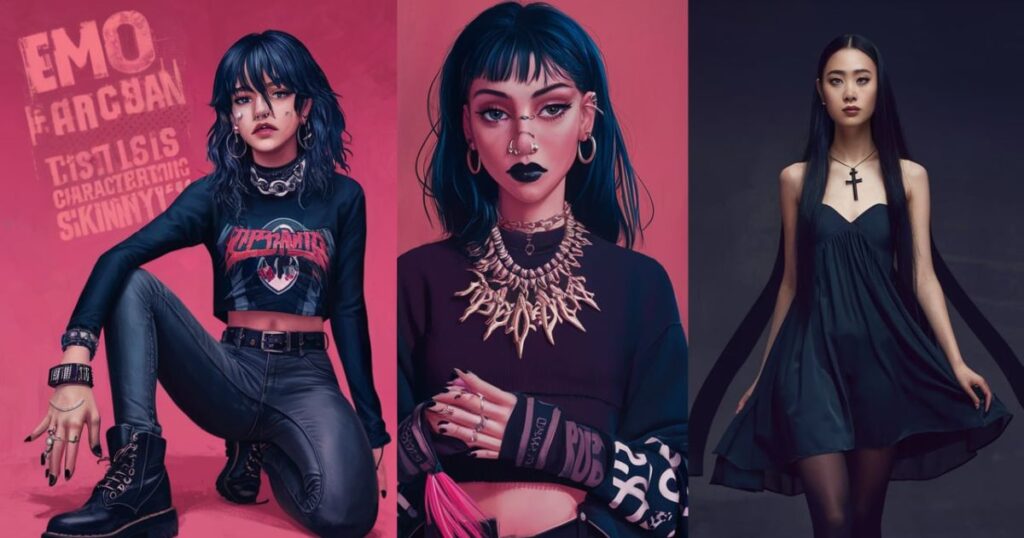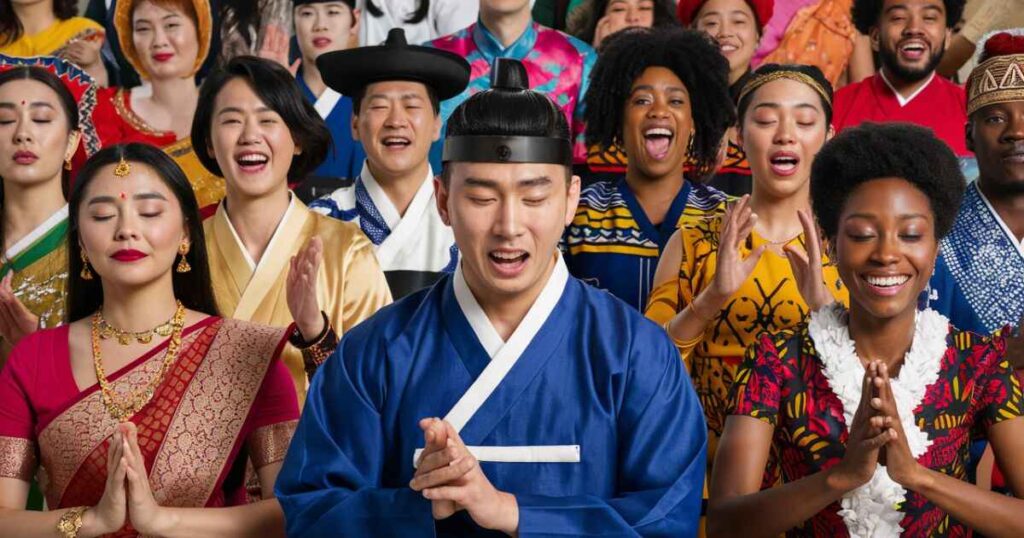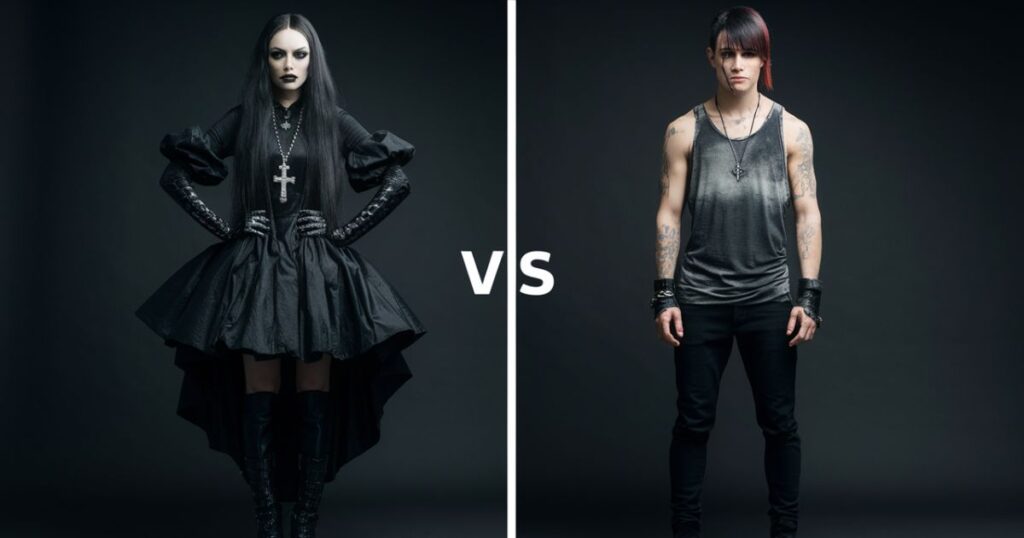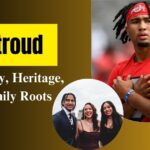In the vibrant landscape of alternative subcultures, emo and goth fashion stand out as two distinctive styles that often captivate and occasionally perplex observers.
While both share an affinity for darker aesthetics, the differences between emo and goth fashion run deep, rooted in unique cultural origins, musical influences, and emotional expressions.
This comprehensive guide will delve into the key distinctions between these two iconic alternative fashion styles, offering clarity for enthusiasts, curious onlookers, and anyone interested in understanding the nuances of subcultural fashion.
Origins and Evolution of Emo and Goth Fashion
Emo Fashion Roots
Emo fashion emerged from the hardcore punk scene of the 1980s, evolving alongside the emotional and expressive music that gave the subculture its name. The style began as a rejection of the aggressive machismo often associated with punk, instead embracing vulnerability and introspection. As emo music progressed through different generations, so did its fashion:
- First Wave (Mid-1980s): Characterized by a DIY aesthetic, band t-shirts, and simple, often thrifted clothing. This era was all about authenticity and raw emotion.
- Second Wave (1990s): Introduced more indie rock influences, with sweaters, thick-framed glasses, and a slightly preppier look. This period saw emo fashion becoming more distinct from its punk roots.
- Third Wave (Early 2000s): Popularized the stereotypical emo look with skinny jeans, studded belts, and side-swept bangs. This era brought emo fashion into the mainstream spotlight.
The evolution of emo fashion reflects the genre’s musical progression from its hardcore punk origins to a more melodic, pop-influenced sound. Each wave brought new elements to the style, creating a rich tapestry of fashion choices that continue to influence alternative fashion today.
Goth Fashion Beginnings
Goth fashion, on the other hand, traces its origins to the post-punk movement of the late 1970s in the United Kingdom. Influenced by Gothic literature, Victorian aesthetics, and a fascination with the macabre, goth fashion developed as a distinct and dramatic style. Key milestones include:
- Late 1970s: Emergence of early goth bands like Siouxsie and the Banshees, influencing a darker aesthetic. This period laid the groundwork for what would become the goth subculture.
- 1980s: Solidification of the classic goth look with all-black outfits, dramatic makeup, and elaborate hairstyles. This decade saw goth fashion truly coming into its own as a distinct style.
- 1990s-2000s: Diversification into various subgenres, each with its own fashion elements. This era saw goth fashion branching out and incorporating influences from other subcultures and historical periods.
The evolution of goth fashion is closely tied to its musical roots, with bands and club scenes playing a crucial role in shaping the aesthetic. Unlike emo fashion, which has seen more dramatic changes over time, goth fashion has maintained many of its core elements while expanding into diverse subgenres.
Key Aesthetic Differences: Emo vs Goth Fashion

The visual distinctions between emo and goth fashion are significant and reflect the different philosophies behind each subculture. Understanding these differences is crucial in answering the question: “What is the difference between emo and goth fashion?”
Color Palettes
- Emo Fashion: Primarily black with bright, often neon accents. Common colors include hot pink, electric blue, and vivid purple. The contrast between dark base colors and vibrant accents is a hallmark of emo style.
- Goth Fashion: Predominantly black, with occasional deep jewel tones like burgundy, dark purple, or forest green. The overall palette is much darker and more monochromatic than emo fashion, emphasizing depth and shadow.
Clothing Choices
Emo fashion typically includes:
- Skinny jeans or tight pants, often in black or bold colors
- Band t-shirts, frequently layered with long-sleeved shirts for added dimension
- Hoodies with band logos or ironic slogans, serving as both fashion statements and emotional shields
- Colorful sneakers, particularly Converse or Vans, often adorned with doodles or customizations
Goth fashion features:
- Victorian-inspired clothing like corsets, frilly shirts, and lace-trimmed garments
- Leather jackets and pants, adding an edge to the romantic elements
- Flowing, dramatic dresses and skirts, often in luxurious fabrics like velvet or satin
- Platform boots or elaborate Gothic footwear, emphasizing height and drama
Accessories
Emo accessories often include:
- Studded belts, sometimes worn multiple at a time
- Wristbands and rubber bracelets, often bearing band names or slogans
- Colorful plastic jewelry, adding pops of brightness to dark outfits
- Pins and patches representing favorite bands, creating a personalized look
Goth accessories tend to be more elaborate:
- Ornate silver jewelry, often with occult symbols or Victorian motifs
- Chokers and neck corsets, emphasizing the neck and décolletage
- Fishnet gloves or arm warmers, adding texture and intrigue
- Vintage-inspired brooches and cameos, connecting to historical aesthetics
Makeup Techniques
Emo makeup focuses on:
- Heavy black eyeliner, often extending beyond the eye in dramatic wings or smudged for a “slept-in” look
- Occasional use of bright eyeshadows, particularly on the lower lash line
- Natural or pale foundation, creating a canvas for expressive eye makeup
- Minimal lip color, keeping the focus on the eyes
Goth makeup is more dramatic:
- Extremely pale foundation, often achieving a porcelain-like complexion
- Dark, smoky eye makeup, sometimes incorporating deep purples or reds
- Deep red or black lipstick, creating a bold contrast with pale skin
- Sometimes includes face painting or intricate designs, particularly for special events or club nights
Hairstyles: A Crucial Element in Emo and Goth Fashion
Hair plays a pivotal role in both emo and goth aesthetics, often serving as one of the most recognizable features of each style. The differences in hairstyles between emo and goth fashion are stark and contribute significantly to the overall look.
Characteristic Emo Hairstyles
- Side-swept bangs covering one eye, a signature emo look that symbolizes emotional mystery
- Choppy, layered cuts that add texture and dimension
- Dyed hair, often with streaks of bright colors like pink, blue, or green
- Straightened hair for both male and female styles, creating a sleek, controlled look
Emo hairstyles often require significant maintenance and styling, with flat irons and hair dye being essential tools. The emphasis is on creating a look that appears both carefully crafted and emotionally charged.
Distinctive Goth Hair Looks
- Teased, voluminous styles that create dramatic silhouettes
- Long, flowing hair (particularly for women), often with blunt bangs
- Jet black color, sometimes with unnatural shades like blue or purple for added intrigue
- Dramatic undercuts or partially shaved heads, combining edginess with traditional goth elements
Goth hairstyles tend to be more diverse than emo styles, ranging from elaborately backcombed creations to sleek, vampiric looks. The key is to create a hairstyle that complements the overall dark, romantic aesthetic of goth fashion.
Cultural and Emotional Expressions in Fashion

The differences between emo and goth fashion extend beyond mere aesthetics, reflecting deeper cultural and emotional expressions. This aspect is crucial in understanding what sets emo and goth fashion apart on a more profound level.
Emo Fashion as Emotional Outlet
Emo fashion serves as a visual representation of emotional vulnerability and introspection. It reflects themes of:
- Personal struggles and angst, often expressed through song lyrics printed on clothing
- Romantic heartbreak, symbolized by heart motifs and melancholic imagery
- Feelings of alienation and misunderstanding, reflected in the use of dark colors and introspective slogans
- A desire for authentic self-expression, seen in the personalization of clothing and accessories
Emo fashion is deeply connected to the emotional states of its wearers, serving as a form of non-verbal communication about their inner worlds. The style allows individuals to wear their hearts on their sleeves, quite literally at times.
Goth Fashion as Lifestyle Aesthetic
Goth fashion, in contrast, embodies a broader lifestyle and philosophical outlook:
- Celebration of darkness and mystery, reflected in the all-encompassing use of black and dark imagery
- Appreciation for Gothic literature and art, seen in the incorporation of romantic and Victorian elements
- Rebellion against societal norms, expressed through dramatic and unconventional clothing choices
- Exploration of taboo subjects and the macabre, symbolized by occult symbols and death-related imagery
Goth fashion is less about expressing personal emotions and more about embracing an entire aesthetic and philosophical worldview. It’s a lifestyle choice that extends beyond clothing into music, literature, and art preferences.
Music’s Influence on Emo and Goth Fashion Trends
Both emo and goth fashion are intrinsically linked to their respective music scenes, with bands and musicians often serving as style icons. This connection between music and fashion is a key factor in understanding the difference between emo and goth styles.
Emo Music and Fashion Connection
Emo fashion has evolved alongside the genre’s musical progression:
- Early emo bands like Rites of Spring influenced a more punk-inspired look, with simple, DIY aesthetics
- Mid-2000s bands like My Chemical Romance popularized the “classic” emo style, including skinny jeans and dramatic hair
- Contemporary emo-influenced artists continue to shape fashion trends, blending elements of hip-hop and pop into the emo aesthetic
The close relationship between emo music and fashion means that as the genre evolves, so does the style. Band merchandise plays a significant role in emo fashion, with fans often building their wardrobes around their favorite artists.
Gothic Rock’s Impact on Goth Style
Goth fashion takes significant cues from gothic rock and its offshoots:
- Bands like The Cure and Bauhaus set early goth fashion trends, influencing the use of black clothing and dramatic makeup
- Industrial and cyber goth styles emerged with electronic-influenced goth music, incorporating futuristic elements
- Romantic goth fashion draws inspiration from darkwave and ethereal wave genres, emphasizing Victorian and Renaissance aesthetics
The diversity of goth music subgenres is reflected in the variety of goth fashion styles. Each musical offshoot tends to have its own associated look, contributing to the rich tapestry of goth fashion.
Conclusion
The differences between emo and goth fashion reflect the unique cultural, musical, and emotional foundations of each subculture. While both styles may share some superficial similarities in their use of dark colors, they represent distinct forms of self-expression and cultural identity. Emo fashion tends to be more emotionally expressive and contemporary, while goth fashion embraces a broader, historically-influenced aesthetic of darkness and mystery.
Understanding these differences not only clarifies common misconceptions but also fosters appreciation for the rich diversity within alternative fashion. Whether you’re drawn to the emotional vulnerability of emo style or the dark romanticism of goth fashion, both subcultures offer compelling ways to express individuality through clothing, accessories, and overall aesthetic choices.
As fashion continues to evolve, elements of both emo and goth styles continue to influence mainstream trends, demonstrating the enduring appeal of these alternative aesthetics. By recognizing and appreciating the unique characteristics of emo and goth fashion, we gain insight into the complex world of subcultural expression and the powerful role that fashion plays in shaping identity and community.

Ella Marie is a dedicated fashion enthusiast committed to curating the latest trends and timeless styles. With a keen eye for detail and a passion for elegance, they ensure every visitor finds inspiration and sophistication on the site.








